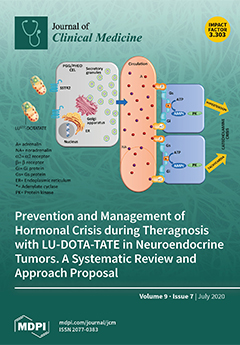The current study endeavored to closely compare the detection rate of 68-Gallium labelled prostate-specific membrane antigen ([
68Ga]Ga-PSMA) versus [
18F]Fluorocholine in men with prostate cancer (PC), to investigate the benefits and pitfalls of each modality in the setting of various patient characteristics. We retrospectively analyzed 29 biopsy-proven PC patients in two categories, staging and restaging, who underwent both scans within a maximum of 30 days of each other. Variables including patient demographics, prostate specific antigen (PSA) level, Gleason score, clinical course, and following treatments were recorded. The number and location of suspicious lesions as well as uptake values were noted. A total of 148 suspicious lesions were detected, of which 70.9% (105/148) were concordantly visualized in both imaging modalities. [
68Ga]Ga-PSMA positron emission tomography/computed tomography (PET/CT) revealed a higher number of metastatic lesions per patients (91% vs 78%). The mean of maximum standardized uptake value (SUV max) in concordant lesions was significantly higher in [
68Ga]Ga-PSMA compared to [
18F]Fluorocholine PET/CT (14.6 ± 8.44 vs. 6.9 ± 3.4,
p = 0.001). Discordant lesions were detected by both modalities, but more frequently by [
68Ga]Ga-PSMA PET/CT (20.3% in [
68Ga]Ga-PSMA versus 8.8% by [
18F]Fluorocholine PET/CT). In patients with PSA levels below 1.0 ng/mL and <2.0 ng/mL, [
18F]Fluorocholine PET/CT detection rate was half (57% and 55%, respectively) that of [
68Ga]Ga-PSMA PET/CT. Tumor, nodes and metastases (TNM) staging, and subsequently patient management, was only influenced in 4/29 patients (14%), particularly by [
68Ga]Ga-PSMA PET/CT with PSA values under 0.5 ng/mL. [
68Ga]Ga-PSMA PET/CT revealed superior diagnostic performance to [
18F]Fluorocholine PET/CT in staging and restaging of PC patients, especially in cases with low PSA levels. However, in a few hormone resistant high-risk PC patients, [
18F]Fluorocholine PET/CT may improve overall diagnostic accuracy.
Full article






